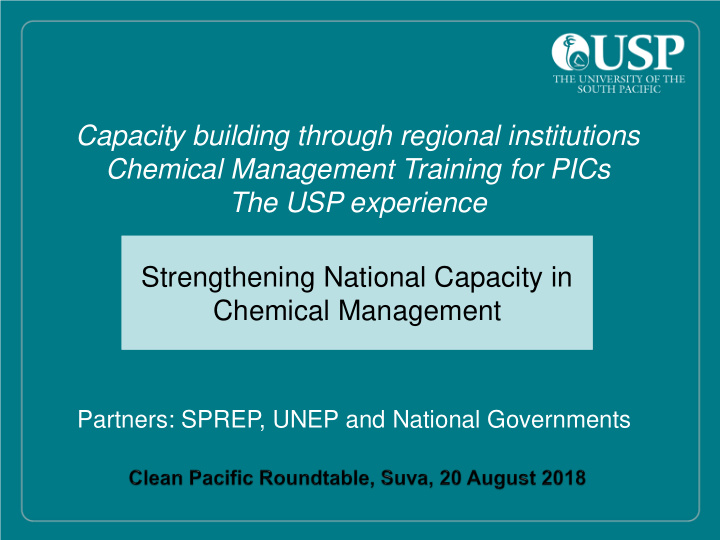



Capacity building through regional institutions Chemical Management Training for PICs The USP experience Strengthening National Capacity in Chemical Management Partners: SPREP, UNEP and National Governments
Establi ablish sh Best t Practi tice (Manual nuals/T /Tool olkit kits) Chemical Management Dissemin seminate e Implem plemen ent t Best t Best t Pract ctic ice Practi tice (Train inin ing) g) (Acti tion n Plans)
Aim of the Project A major objective of the Pacific POPs Release Reduction Project is to enable regional Parties to the Stockholm Convention to meet their national obligations to improve the management of chemicals
Project Key Objectives • To increase PICs capacity to support the implementation of the Stockholm Convention • And to meet their national obligations to improve the management of chemicals and chemical waste, through the provision of an integrated chemical management training programme
Target Audiences Government employees with responsibilities for the regulation of chemicals, or for related aspects such as environmental protection, worker health and safety, or public health. Managers and technical staff of chemical laboratories, including from government agencies (eg. Health, Agriculture, Environment), local authorities and related bodies (eg. water supply authorities), and the private sector. Education sector representatives with specific responsibilities for school laboratories. Customs personnel, especially those involved in administration or enforcement of the chemical and waste MEAs, or imports of dangerous goods.
Project Team • IAS-USP staff and partners • Good mix of technical expertise and teaching experience • Training modules (31 modules) and resource materials - prepared by the Technical Team • In-country training – conducted by the IAS project delivery team
Topics • Chemical classification and labelling • Best practice chemical management • Chemical inventories • Safe handling, use and disposal • National, international and regional obligations, including those under the Stockholm, Rotterdam, Basel and Waigani Conventions
Outcomes • Greater awareness of the range of potential hazards associated with chemicals and chemical wastes • Increased understanding how chemicals can act on people or enter the environment • Enhanced ability to describe the most appropriate ways of working with those materials, including generally recommended procedures for safe storage, handing, use and disposal • Understanding the steps involved in preparing a chemical inventory, and the ways in which this information should be used • Appreciating the national and international controls currently in place for managing specific groups of hazardous chemicals and hazardous wastes
Our learning • Lack of chemical management knowledge and competencies was evident • Chemicals are poorly managed in almost all countries, e.g no proper inventory, storage and disposal facilities • Eye-opener for most participants about OHS issues, e.g. school and hospital labs • Lack of PPE • Custom officers unaware of and unequipped to deal with chemical hazards • Training was highly needed and needs to be systematised and formalised • Over 450 people trained
Chemicals poor storage
Chemicals poor storage
National Priorities Identified – Summary 1 • Inventory and Disposal issues for laboratories in government, health and education sectors in particular • Appropriate collection, storage and disposal of waste • Identification of unknowns (especially surplus chemicals in education and health labs) • Need for appropriate PPE and signing • Development/maintenance of a national chemical inventory
National Priorities Identified – Summary 2 • Strengthening information sharing and cooperation between agencies (including Customs) to enable enforcement (e.g. in regard to SC, Basel and Waigani) • Registration of pesticides to be made mandatory • Specialised and detailed training on the conventions • The need to conduct refresher training
Participants feedback • Positive feedback has been received from the participants on the in- country training • Initiative of in-house training has been taken up by some of the participants • Positive interaction during group work and site visits – led in enhancing learning • Participants have found that all Topics to be very relevant and could easily relate to the many aspects of chemical management in their workplace • Important follow-up aspects that Participants have commented: – Development of national inventories – Actual removal and disposal of hazardous waste from their countries – Quick implementation of the National Action plan – Regular/refresher training and for this training to be made available to more people
Trainers with Participants of Cook Islands
Site visit – Cook Islands
Site visit - Vanuatu
Spill Response Demonstration - Kiribati
Inventory Exercise - Kiribati
ChemTrain – Solomon Islands
Interactive Group Discussion – Solomon Islands
RMI Participants
Acknowledgement • SPREP • UNEP • National Governments • The Institute of Applied Sciences (IAS)
Vinaka
Recommend
More recommend